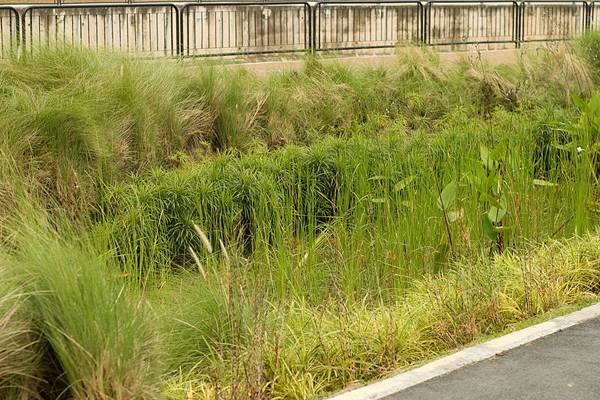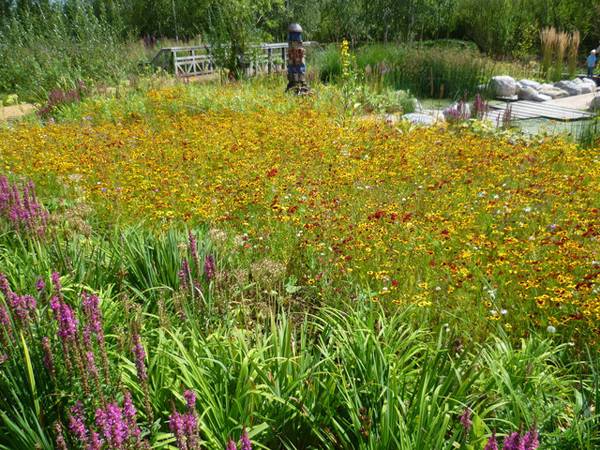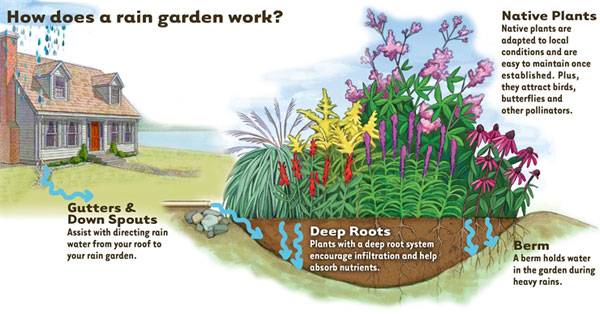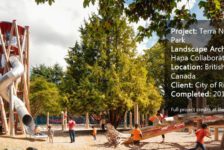Rain Gardens: Embracing the Environment to Create Thoughtful Spaces. You probably know from our previous article “Permeable Paving: The Essential Guide” that it is possible to allow water to infiltrate paths and roads with the use of permeable paving. But have you ever heard of the possibility of imitating natural forest infiltration within your own garden?
What is a Rain Garden?
The rain garden, as its name suggests, is a group of planting arrangements that make use of rainwater. The rain garden is usually small and can be incorporated into pretty much any outdoor design. While rain gardens are most commonly found in residential yards, they can also be planted in parking lots and parks. They can even function by themselves as small independent gardens.

Balam Estate Rain Garden provide an effective stormwater management. Water from the rain, passes through the rain garden, and the filtered water then flow into the stormwater drain. Credit: Rogersoh, CC 3.0
- Rain gardens serve as an inexpensive method of reducing stormwater runoff volume and improving stormwater quality as they effectively absorb and reduce pollutants.
- They function like the natural absorption of rainwater in a forest or meadow, often absorbing 30 percent to 40 percent more runoff than a typical garden lawn.
- They endure the extreme moisture and concentration of nutrients such as nitrogen and phosphorus present in stormwater runoff.
- These planting arrangements also contribute to facilitating the infiltration of clean water, therefore conserving it and recharging groundwater.
- Birds and butterflies are provided with an ideal habitat, which in its turn reduces mosquitoes and pests.
What Sort of Plants Should Be Used? In order to attain the desired outcome, one must pay attention to selecting the appropriate plants. Rain gardens work as a balance of properly engineered soils, available space, a well-studied budget, and the right type of vegetation.

Swale and Rain Garden in Traffic Triangle, near Bartrams Garden. Credit: Philadelphia Water Department, CC 2.0
- It is best if the plants used are native. A good investigation of the available local vegetation is thus needed. But native plants are not the only option, as other non-invasive species also can be planted.
- Most rain gardens are generally planted with trees, woody shrubs, or herbaceous perennials. Annuals also can be an option.
- When choosing the rain garden plants, the priority is not the seasonal aesthetics, color, or texture, but creating a garden that needs little maintenance.
- The plants should be tolerant to drought and temporary ponding of rainwater. They must also naturally have deep roots and be able to survive the stress of heavy rainfall, pollutants, and nutrient excess.

RBC Rain Garden at the London Wetland Centre Nearly a year after it opened the Rain Garden (funded by the Royal Bank of Canada) is maturing well. In the photograph is one of the creature towers to provide habitats for insects and small mammals. They have been put together with a variety of materials from slates to sticks. Credit: CC 2.0 © Copyright Marathon
How Does a Rain Garden Work and How to Install it?
The rain garden serves its purpose by capturing rainwater from the roof or ground surfaces and allowing it to soak gradually into the ground. By doing so, the garden filters contaminants and conserves clean water, which would have been otherwise wasted in the sewer system or flooded in the streets.

Image credit: Tip of the Mitt Watershed Council.
- Rain Gardens: Managing Water Sustainably in the Garden and Designed Landscape by Andy Clayden
- Rain Gardens: Sustainable Landscaping for a Beautiful Yard and a Healthy World by Lynn M. Steiner
Article by Dalia Zein Return to Homepage Featured image: Public Domain CC 1.0, source
Published in Blog









